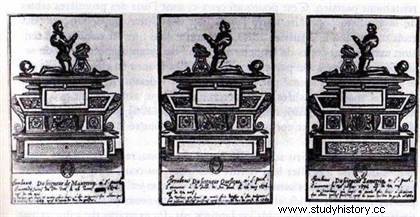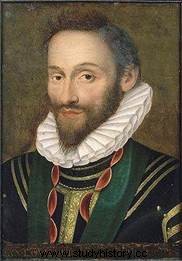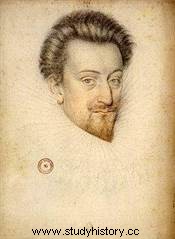 The majority of the members of the first cute group could not obtain important positions and positions, some disappeared during the great duel in 1578, others were disgraced. Finally, some former companions of the king had more luck and lived in the time of Henri IV, then Louis XIII in respectable positions. Here is their short curriculum vitae for each of them.
The majority of the members of the first cute group could not obtain important positions and positions, some disappeared during the great duel in 1578, others were disgraced. Finally, some former companions of the king had more luck and lived in the time of Henri IV, then Louis XIII in respectable positions. Here is their short curriculum vitae for each of them.
Louis de Béranger, Lord of Guast, 1540-1575
Originally from Dauphiné, gentleman of the chamber in 1570 was also commander of the regiment of the French guards. Special agent of the king and providing a filter of access to the sovereign, he followed him to Poland in 1574 and was employed to thwart the policy of Monsieur. The Guast is delegated to Bussy (former royal companion who went to Monsieur) to look for him. When Monsieur fled in September 1575, Le Guast was commissioned to close the roads and ports. Marguerite de Navarre accuses him of having reported to the king his relations with Bussy. Following a quarrel with a gentleman from Montmorency who described him as proud and a creature of the king, he died at the beginning of November 1575, assassinated with a dagger and sword around 10 p.m., in his house rue Saint Honoré, either he was reading poetry, or he had a manicure. Le Guast, in his agony, recognized the Baron de Vitteaux, a client of Monsieur. The king offers a solemn funeral in the church of St Germain l'Auxerrois, royal parish!
Henri Hébrard of Saint Sulpice, 1553-1576
Originally from Haut Quercy, from a family that has received almost all possible distinctions. He was first in the service of Monsieur, before the latter left the court in 1575. Saint Sulpice acceded to the king supported by his father Jean Conseil d'Etat and the Guises as protector until he became captain of light horses. in 1575. After being called "not to be a gentleman" by an officer of Monsieur's household, he was killed with a dagger in the courtyard of the Château de Blois in 1576 and died in his father's arms. The court condemning this assassination, the Duke of Mayenne is determined to have the murderer punished, whose effigy will be beheaded in June 1577. For services rendered, the king orders an epitaph.
Jacques de Levis, Count of Caylus, 1554-1578
Originally from Rouergue, cousin of Saint Sulpice, was only eighteen when he met the king. Captain of a hundred light horses in 1575, he received nineteen blows during the famous duel, and died after thirty-three days of agony. The king visits him twice a day and prohibits all traffic in the rue Saint Antoine to avoid any noise for the patient. For Henry III, it was a shock, Caylus being his favourite. The king is weakened and has no will. During the funeral the deceased is exposed with his face uncovered, the king obliges the court to attend the procession and he himself goes into mourning (something never seen for a subject).
Louis de Maugiron, 1560-1578
 Originally from Vienna, from a family serving as a bulwark in the provinces against the Huguenots, initially belonged to Monsieur. The king attracted him and offered him the position of Business Chamberlain, the highest position in the king's household, from 1576 (he was only sixteen years old). During the duel of the mignons, he died immediately.>
Originally from Vienna, from a family serving as a bulwark in the provinces against the Huguenots, initially belonged to Monsieur. The king attracted him and offered him the position of Business Chamberlain, the highest position in the king's household, from 1576 (he was only sixteen years old). During the duel of the mignons, he died immediately.>
Philibert d'Aure de Gramont, Count of Guiche, 1552-1580
Originally from a prestigious lineage in Béarn. Obtaining the office of captain of the gendarmes, then the post of gentleman of the chamber, he was mainly used as the king's representative in the lands of Navarre and became mayor of Bayonne. He participated indirectly in the quarrel of the favorites against the minions of Monsieur in early 1578, then was attached to the Business Council in 1578. Finally he died at the siege of La Fère in 1580.
Gaspard de Schomberg, 1540-1599
Of German lineage, in the service of the Duke of Guise, meets the king during jousts where the two men fall at the same time (the king dislocating his shoulder, Schomberg injured in the face). Ordinary chamberlain in 1571, he accompanied the king to Poland in 1573 serving as his ambassador and diplomat. Grand Marshal of the Reîtres, he took part in the reconciliation between Guise and Epernon, then in 1589 in that between Navarre and Henri III. An outstanding negotiator, he drafted part of the Edict of Nantes and on returning from the reconciliation between Epernon and Sully, he died of a heart attack in 1599 at the age of 59. His brother Georges, born in 1555, joined him in 1569 and entered the service of the king. He died immediately during the duel of the Mignons in 1578.
François d'Aydie-Ribérac, 1550-1578
Originally from Béarn, in the service of Monsieur, is called by the king. Not accompanying him to Poland, he was only ordinary gentleman of the chamber in 1576. Participating in the duel of 1578, he died the next day.
Guy d'Arces, baron of Livarot, 1555-1581
Originally from Dauphiné, first cousin of Maugiron, joined the house of Monsieur in 1576, which he left definitively in 1577, attracted by the king. Appointed chamberlain at the end of 1576, then gentleman of the chamber in 1578, he was camp master of the infantry when he died in 1581. He was one of the two beaus to have survived the duel, after six weeks of illness. .
Charles de Balsac, Baron d'Entragues, known as Entraguet, 1547-1599
Coming from a family of Haute Auvergne, child of honor of the children of France in 1549, then handlebar, he is the first companion of the king from 1571. He accompanies him in his amorous adventures, became captain of the gendarmes, councilor of state in 1583, lieutenant general of duchies, knight of Saint Esprit in 1595. During the duel of the mignons, he escaped with a scratch on his arm!
Paul de Stuer de Caussade, Sieur de Saint Mégrin, 1554-1578
Originally from Saintonge, heir to a considerable fortune, became a gentleman of the chamber, then quickly received official charges and responsibilities with a position as camp master of the light cavalry in 1578. Not having taken part in the duel of April, whereas he strongly wished it, he begins to harass the duke of Guise who feels obliged to take up the challenge and who sends his brother Mayenne for the assassination in reason that Saint Mégrin would have courted the Duchess of Guise. His body was hacked with twenty blows, in the middle of rue Saint Honoré on July 21, 1578, at the end of the king's bedtime. He dies the next day.
Jean Louis de Nogaret de La Valette, known as d'Epernon, 1554-1642

François d'Espinay de Saint Luc, 1550-1597
Of very modest Norman origins, achieved his rise thanks to his military merits. Captain of an infantry company in 1571, gentleman of the chamber in 1574, he became the main favorite with Caylus, Maugiron, Saint Mégrin, then Councilor of State and chamberlain in 1578. After the disappearance of the mignons and the disgrace of O, Saint Luke thought he would get closer to the king, but did not receive the office of Grand Ecuyer promised by Henry III. Angry, he will make mistakes after mistakes until his disgrace in 1581:he establishes other contacts so as not to have to depend only on the king, he approaches Monsieur, rumor has it that Saint Luke would have offered his services to the queen to conceive a dolphin, he dares to claim that the king is not a good catholic, he reveals the secret that the king loved a lady of condition, secret reached the ears of the queen, he locks himself in his lands and refuses to open the doors of Brouage to anyone, even less to the king's envoys. In 1585, he approached the Duke of Nevers, allied himself with the Catholics as opposed to the Huguenots, while trying to return to favor, but the king did not budge. He will be faithful to Henri IV, will attend the coronation, obtains the office of provincial lieutenant general and grand master of the artillery, then dies in 1597 in the middle of the siege of Amiens.
Gilles de Souvre, Sieur de Courtanvaux, 1542-1626
Originally from Perche, is a gentleman of lesser nobility entering the second nobility through alliances and direct service of the king. First with Monsieur in 1572, he obtained the post of master of the king's wardrobe in 1573, accompanied him to Poland and prepared his return in 1574, becoming chamberlain. In 1578, he participated in the opposite cabal, quarreled with Epernon and was slightly disgraced. Recovered by Monsieur, the king did not hold it against him too much, and when he rejoined the court in 1581, Souvre was sent to the provinces only as lieutenant general, because he was considered a loyal agent and no longer an intimate. Ordinary chamberlain and business adviser in 1582, he will remain in the background. Still Governor of Tours, he carried the Holy Ampulla for the coronation in Chartres of Henri IV. Appointed governor of the Dauphin Louis XIII, he died at the age of 84 in 1626.
Antoine de Brichanteau de Beauvais-Nangis, 1552-after 1612
Originally from Beauce, he is more a soldier than a courtier. Camp master of the French guards but above all jealous of the favors granted to the other mignons, he fell out with Saint Luc, d'O, Caylus, and especially Epernon, because he received the post of colonel general of the infantry promised by the King. Disgraced in 1581, feeling betrayed, he opposed Henri III and finally joined the League in 1585, out of resentment towards Epernon. Supported by Richelieu, who became Grand Provost, he returned to court in 1587, became Admiral of France in 1589, and for services rendered, his lands were elevated to the marquisate in 1612.
François d'O, marquis, 1551-1594
Supported at court by his father, he became master of the wardrobe, first gentleman, lieutenant general and assumed various official responsibilities, especially in the financial field. Although in court and although involved in settling scores, he was never worried. Epernon, wanting the monopoly of favor, discredits him with the king by accusing him of maintaining secret relations with Monsieur and of disclosing state secrets to him. Temporarily disgraced in 1581, d'O lost his position as master of the wardrobe but did not leave the capital, and returned to court thanks to Joyeuse, the king needing his former followers to thwart the actions of the leaguers. He died of illness in 1594, but we hear about him until 1655, at the end of the lawsuits launched by his family to recover the loans granted in his time to Henry III.
Anne de Joyeuse, Baron of Arques, 1560-1587
 Originally from Ardèche, linked to the Montmorencys and belonging to the house of Monsieur, fought in Languedoc, then was wanted by the king for his military values. Quickly, he obtained pre-eminence over the dukes and peers. By marrying the queen's sister, he becomes part of the royal family. Joyeuse is kind, generous and gave his gentlemen, embodying an ideal of nobility, the paragon of cultivated nobility, the perfect gentleman refusing nothing to the king, considered as a spiritual son, "the masterpiece of the prince". For the king, any departure on the campaign is a real heartbreak. Captain of fifty lances, then of a hundred lances, he became military commander of the royal cavalry with twelve light horse companies in 1586. Always ready to go to the front, he rose to the position of commander-in-chief of the navy and the army. infantry, then admiral. Feeling excluded from the king's entourage (because of Epernon), he threw himself headlong into the battle of Coutras in September 1588 and died there.
Originally from Ardèche, linked to the Montmorencys and belonging to the house of Monsieur, fought in Languedoc, then was wanted by the king for his military values. Quickly, he obtained pre-eminence over the dukes and peers. By marrying the queen's sister, he becomes part of the royal family. Joyeuse is kind, generous and gave his gentlemen, embodying an ideal of nobility, the paragon of cultivated nobility, the perfect gentleman refusing nothing to the king, considered as a spiritual son, "the masterpiece of the prince". For the king, any departure on the campaign is a real heartbreak. Captain of fifty lances, then of a hundred lances, he became military commander of the royal cavalry with twelve light horse companies in 1586. Always ready to go to the front, he rose to the position of commander-in-chief of the navy and the army. infantry, then admiral. Feeling excluded from the king's entourage (because of Epernon), he threw himself headlong into the battle of Coutras in September 1588 and died there.
Roger II de Bellegarde, Baron de Termes, 1567-1646
Protected from Epernon, last favorite because the king needed a confidant, became chamberlain, master of the wardrobe in 1587, grand squire of France, obtaining none government under Henry III, only two light horse companies of the guard. Duke and peer under Louis XIII, he allies with Montmorency, which causes the loss of his property and his titles.
